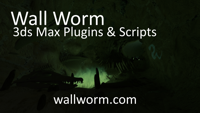Bitmaps to Materials
This document explains how to use the Bitmaps to Materials rollout in Wall Worm. Of important note is that the Bitmaps to Materials rollout works best if you have the Bitmap2Material Substance from Allegorithmic installed. Furthermore, for Source, make sure that you have the old version (B2M v2) installed, as it aligns better with the Source shader workflow.
Generate Material Library from Bitmaps
Blended Maps
Use the blended maps section to convert six bitmaps into a triplanar map tree that does not require any UV coordinates on your object. Note that 3ds Max 2017.1+ has a native BlendedBoxMap texture; the functions below will use that texture node for 3ds Max 2017.1+ or a more complex shader tree for older versions of Max.
The blended mapping function shader was heavily influenced by the Blended Box Mapping technique demonstrated by Neil Blevins. The primary difference is that the mapping is handled entirely in the shader and can be re-used with arbitrary objects without need of applying UV modifiers.
Properly using the Blended Maps requires you to understand some of the settings and techniques. Here are good candidates for using this blend mapping setup:
- The materials are used on non-animated objects (landscapes, static props).
- The materials are used on a single animated prop.
- The materials are used on multiple animated props that share common dimensions in X/Y/Z.
- The objects using this method are not deforming (with modifiers like Skin, Morpher, Bend, etc). If used on such objects, you'll need to bake the textures to bitmaps.
If your material must be used on multiple animated objects that do not share similar dimensions, then you may need to utilize a different method.
Blend Maps User Interface
- Get Random Files
-
This button will find random images from the folder search settings at the top of the UI and fill them into the six texture slots. With a left click, all six images are completely random. With a right-click, one single image is randomly selected but that same image is placed into all six slots.
- Randomize Existing Files
-
This button will resort the six images randomly (swapping top, left, front, etc).
- Blend Mapping
-
This menu determines the mapping type used in the textures. The mapping type can be either World or Object. Which setting is used will dramatically affect how the textures work.
- World: Use this for landscape materials and on objects that do not animate. The map coordinates are tied to the world.
- Object: Use this on objects that animate (or extremely large landscapes that cannot fit their tiling value in the allowed limits of the coordinates tiling spinners). The mapping coordinates and scale are tied to the object transformation and dimension.
- World Tiling
-
This value is how many times the texture will tile in world space when the Blend Mapping is set to World. Lower values make textures appear larger in renders, while higher values make the textures smaller (tiling more).
- Object Tiling
-
This value is how many times the texture will tile in Object space when the Blend Mapping is set to Object. Lower values make textures appear larger in renders, while higher values make the textures smaller (tiling more).
- Tile Instancing
-
This dropdown selects the instancing settings for the tiling settings. Generally you should set this to Instance ALL Tiling Parameters when using World Mapping and Instance Each Axis Separately when using Object Mapping.
- No Instancing of Tiling Parameters: this means that once generated, all of the tiling settings in the six textures are independent.
- Instance ALL Tiling Parameters: this means that every U/V tiling parameter in all six textures will always be identical (changing one changes all others). This is ideal for world mapping (landscapes, static rocks, etc) or object mapping where the object dimensions are generally equal in all three axes.
- Instance Each Axis Separately: this will instance the X axis of textures using X, Y axis if thos using Y and Z axis of those using Z. This means that changing the X value will update the tiling of those other textures, using X, etc. This is useful if the dimension of your object using the material is not cubic. Generally used with Object Mapping.
- Rotate
-
When on, each of the six textures will be rotated randomly from 0-360 degrees an the W Angle. This is good when using B2M or have tiling textures.
- Offset
-
When on, each of the six texture is randomly offset in U/V. This is good when using B2M or have tiling textures.
- Post Create Action
-
This menu sets what happens after the material is generated.
- Replace MultiMaterials
-
When on, each selected object will have its material replaced with newly generated materials. When off, the material will be added to a submaterial of any object that has a Multi-Material instead of replacing it.
- Use B2M Substance
-
When on, each bitmap will be used as the source image of a Bitmap2Material Substance and the material will include Diffuse, Specular Level and Bump from the respective substances. When off, just diffuse textures are used in the diffuse slot. Requires Bitmap2Material to be installed.
Blended Map Hints
When using the Blended Maps, there are some things to know about. Here are a few tips:
- There seems to be a bug in Substance maps where the values of the coordinates won't update for a texture until you open the substance in the material editor. This is most prominent when using instanced tiling values. If you have the tiling instanced on each axis separately in Object Mapping, you may find that one or more sides of the object aren't updating properly in the render. To fix this, double-click on the substances in Slate to force it to update.
- Related Topics





